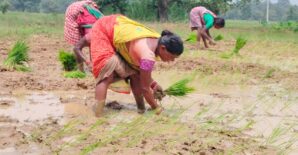Identifying reverse migration and disruption in urban activities as prime issues in the context of COVID-19 in India, compounded by general livelihood and food insecurity, Dr P K Joshi focuses on the recovery plan. As agriculture has been the most resilient in the COVID-19 period, the five-point plan comprises first sectoral prioritization of agriculture in recovery plan, expansion of agricultural exports, incentivizing migrants to return to urban centres (as agriculture and rural areas have no absorption capacity), addressing micro and small enterprises (critical part of agri-food system) and increased corporate sector participation in agriculture – Devesh Roy, series co-editor and Senior Research Fellow, Agriculture for Nutrition and Health (A4NH).

Haryana: Farmers harvesting after government announces agriculture activities as under essentials services during COVID1-9 lockdown. Shutterstock/Photographielove
The sudden outbreak of the COVID-19 pandemic compelled the Indian government to abruptly enforce a country-wide lockdown, which has been extended four times. The lockdown has helped in checking the spread of the virus to a large extent, but the food and livelihood security of the urban poor, particularly daily wage earners, casual labourers, and migrant workers have been compromised. Despite food security measures and announcements of economic packages, there are three major challenges arising due to the lockdown.
Reverse migration of workers
The first major challenge spurred by the lockdown is the large-scale reverse migration of workers from cities to villages, which is not usual, unless in calamities such as floods, earthquakes, wars or conflicts. The threat to lives of these workers and their families and the loss of livelihood has led to uncertainty about their food and incomes, resulting in this exodus. This phenomenon is expected to imbalance the rural labour market, where under-employment and disguised unemployment are persistent problems. With the tiny size of land holdings (the average size for India is about 1 hectare), and the lack of lucrative and sustained employment opportunities, the movement of labour from urban to rural areas is expected to put tremendous pressure on the already appalling low land-man ratio, and compete with local labour. Nearly 9 million people migrate within the country annually, mostly in search of work1. It is likely that with the pressure on food and employment increasing substantially in rural areas, rural poverty and wages might get adversely impacted.
Food, income and livelihood insecurity
Secondly, the present situation may aggravate food and livelihood insecurity in rural areas. The farm sector reels under disguised unemployment, under-employment, and low labour productivity, and the rural non-farm sector has scarce employment and income-generating opportunities. Majority of MSMEs (micro, small and medium enterprises) are not labour-intensive, thereby having limited capacity to absorb migrant labourers. These conditions are likely to pose tremendous problems of food and income insecurity for the migrant workers returning home.
Long-term disruption in urban economic activities
Thirdly, it is going to be a significant challenge to bring these migrant workers back to the cities after the relaxation of the lockdown. Although, in principle, labour demand and supply should clear the labour market on its own, it is expected that the migrants may not return in the short-run due to fear of the virus and of being stuck without any source of income far away from their homes in case of Panother lockdown. The urban economy contributes almost 70-75% to India’s gross domestic product. With both labour and capital in short supply, economic activities in the urban sphere will take time to catch up, adversely affecting the whole economy.
The way forward
The coronavirus pandemic has led to the diversion of a significant share of government’s resources to the health sector and the economic packages for ensuring the safety and food security of the poor and displaced. Multiple extensions of the lockdown have left the private sector in a limbo, limiting its capacity to infuse the economy with a stimulus. With the containment of the spread in virus still nowhere in sight, the economy is projected to experience recession. And while a lot of work is in progress, the suggested five-point action program can offset the adverse impacts of the lockdown and bring the economy back on track.
Prioritize agriculture sector
The government in its efforts to revive the economy must accord its highest priority to the agriculture sector as it has been least affected due to the pandemic and the lockdown. The marginal returns from strengthening the agriculture sector will be higher compared to other sectors, both in the short- and medium-term. Focussing on export opportunities could help boost the agriculture sector and would be the dominant strategy for revival. Creating brand value through product differentiation, along with non-price attributes such as grading, hygiene, food safety, and packaging, could help farmers move up the value-chain and make their products competitive in the global market. The economic package announced for agriculture emphasizes this, but the mechanisms are not clear. A successful kharif harvest will require effective backend support by energizing agri-inputs delivery system, especially seed, fertilizer, pesticide, feed, and fodder. Easy access of quality farm inputs and services at reasonable prices will be key. It is an opportune time to attract the corporate sector to unlock the rural markets for ‘farm inputs and retail services’, the way online markets are expanding for food and non-food commodities in urban areas.
Lead agricultural and meat exports globally
India, a net exporter of agricultural commodities, could use this crisis as an opportunity and lead the agricultural trade globally. India has announced that it would export about 90,000 tonnes of wheat to Afghanistan and Lebanon under government-to-government trading arrangement. With a bumper harvest of over 107 million tonnes in the rabi season 2020, government stocks are expected to overflow with surplus. With the coronavirus outbreak breaking traditional marketing linkages, India could look to exporting larger quantities (5-8 million tonnes) to neighbouring countries like Nepal, Bangladesh, and Sri Lanka. Rice growers have capped exports due to the pandemic, while global buyers are also looking to build inventories to feed their people. India, the largest exporter of rice, could use this as an opportunity and exports could surge by 15% in 2020-21, which could ease global supply constraints as well as domestic stocks. The export of non-basmati rice could also rebound with a firming of global prices. Maize surpluses could find competitive markets in the far East and West Asia. A slump in beef production in Australia, shutdowns in North America, and infections at plants in Brazil, that constitute about two-third of global trade, also present a unique opportunity for India to ramp up its bovine meat exports to the world. The need of the hour is to identify niche commodities and locations for export, and eliminate shackles in export promotion.
Incentivize migrant workers to return to urban centres
It will be difficult for migrant laborers to find remunerative and sustainable employment opportunities in the rural areas, but they may not return to cities in the short-term. However, in the medium- to long-term, the need to secure a sustainable livelihood may urge them to return. The real challenge is to provide them with safe and hygienic places to live in the cities and the government must focus its energies on arranging for this. Any effort to bring them back without ensuring their safety might lead to counterproductive outcomes in terms of widespread contamination and an explosion in the number of infected persons leading to large-scale losses of lives. Without their return to the urban economic hubs, economic recovery will be very difficult. Therefore, the state governments should (i) register migrant workers returning for work, (ii) ensure their food security, (iii) provide shelter homes in different pockets, and (iv) cover them under Ayushman Bharat program. A package of social, health and income security may attract migrants back to work.
Promote micro, small and medium enterprises
Reviving micro, small and medium enterprises (MSMEs) is key. MSMEs play a vital role in revitalizing rural industrialization. At present, their share in the national gross value added is about 32%. In 2015-16, there were over 63 million unincorporated non-agricultural enterprises (49% in urban areas), employing over 111 million workers (55% in urban areas). Over 20 million enterprises were food-based and could be leveraged for creating backward and forward linkages with agriculture. However, in times such as these, business as usual will not work. In the wake of the spread of the virus, the importance of maintaining food safety, sanitation, and hygiene cannot be overstated, and the government must develop mechanisms for ensuring certain standards are met by these enterprises before they are allowed to be back in business. If this crisis can be utilized to promote MSME with necessary care and precaution, they can be instrumental in generating large-scale employment opportunities in the rural as well as urban sectors, augmenting incomes, and earning foreign exchange through exports. The government has also announced a separate economic package for financing MSMEs to assist them in creating infrastructure and institutions that address their constraints relating to working capital in their recovery post-COVID-19.
Role of corporate businesses to augment agricultural supply chains
Attracting corporate business in the agriculture sector will be essential to strengthen supply chains of agricultural commodities, both at the backend and the frontend. Existing infrastructure for marketing of agricultural commodities is unorganized, inefficient, and fragmented. The government has announced removal of the Agricultural Produce Market Committee Act, allowing direct sale and purchase of agricultural commodities, as well as inter-state agricultural trade. However, to attract bulk buyers, big retailers, and processers to come up with alternative arrangements, appropriate incentives and institutions are necessary.
By ensuring food, employment, and livelihood security, the agriculture sector and MSMEs can act together and lead India’s economic recovery from COVID-19. The nature and timeliness of government response will play a pivotal role in how quickly and steeply our economy recovers from the current crisis.
P.K. Joshi is the Honorary Director, Agro-Economic Research Center, Delhi, and Former Director, South Asia, IFPRI. The analysis and opinions expressed in this piece are solely those of the author.
This blog has been published as a part of the International Food Policy Research Institute (IFPRI), South Asia, blog series on analyzing the impacts of the COVID-19’s pandemic on the sub-national, national, and regional food and nutrition security, poverty, and development. To read the complete blog series click here
1 Economic Survey 2016-17
New research from a Special Issue of Applied Economic Perspectives and Policy
The pandemic caused disruptions to both the supply of and demand for health services that persisted past the lifting of lockdown measures.
Public food transfer programs have traditionally been the most common social protection programs in Bangladesh



